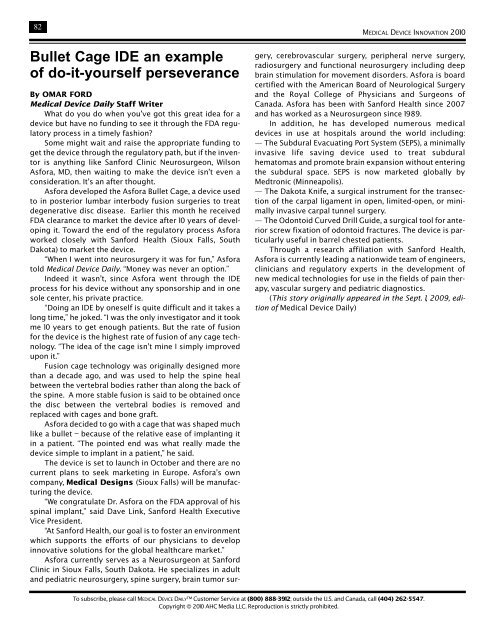MEDICAL DEVICE INNOVATION - Medical Device Daily
MEDICAL DEVICE INNOVATION - Medical Device Daily
MEDICAL DEVICE INNOVATION - Medical Device Daily
You also want an ePaper? Increase the reach of your titles
YUMPU automatically turns print PDFs into web optimized ePapers that Google loves.
82<br />
Bullet Cage IDE an example<br />
of do-it-yourself perseverance<br />
<strong>MEDICAL</strong> <strong>DEVICE</strong> <strong>INNOVATION</strong> 2010<br />
By OMAR FORD<br />
<strong>Medical</strong> <strong>Device</strong> <strong>Daily</strong> Staff Writer<br />
What do you do when you’ve got this great idea for a<br />
device but have no funding to see it through the FDA regulatory<br />
process in a timely fashion<br />
Some might wait and raise the appropriate funding to<br />
get the device through the regulatory path, but if the inventor<br />
is anything like Sanford Clinic Neurosurgeon, Wilson<br />
Asfora, MD, then waiting to make the device isn’t even a<br />
consideration. It’s an after thought.<br />
Asfora developed the Asfora Bullet Cage, a device used<br />
to in posterior lumbar interbody fusion surgeries to treat<br />
degenerative disc disease. Earlier this month he received<br />
FDA clearance to market the device after 10 years of developing<br />
it. Toward the end of the regulatory process Asfora<br />
worked closely with Sanford Health (Sioux Falls, South<br />
Dakota) to market the device.<br />
“When I went into neurosurgery it was for fun,” Asfora<br />
told <strong>Medical</strong> <strong>Device</strong> <strong>Daily</strong>. “Money was never an option.”<br />
Indeed it wasn’t, since Asfora went through the IDE<br />
process for his device without any sponsorship and in one<br />
sole center, his private practice.<br />
“Doing an IDE by oneself is quite difficult and it takes a<br />
long time,” he joked. “I was the only investigator and it took<br />
me 10 years to get enough patients. But the rate of fusion<br />
for the device is the highest rate of fusion of any cage technology.<br />
“The idea of the cage isn’t mine I simply improved<br />
upon it.”<br />
Fusion cage technology was originally designed more<br />
than a decade ago, and was used to help the spine heal<br />
between the vertebral bodies rather than along the back of<br />
the spine. A more stable fusion is said to be obtained once<br />
the disc between the vertebral bodies is removed and<br />
replaced with cages and bone graft.<br />
Asfora decided to go with a cage that was shaped much<br />
like a bullet – because of the relative ease of implanting it<br />
in a patient. “The pointed end was what really made the<br />
device simple to implant in a patient,” he said.<br />
The device is set to launch in October and there are no<br />
current plans to seek marketing in Europe. Asfora’s own<br />
company, <strong>Medical</strong> Designs (Sioux Falls) will be manufacturing<br />
the device.<br />
“We congratulate Dr. Asfora on the FDA approval of his<br />
spinal implant,” said Dave Link, Sanford Health Executive<br />
Vice President.<br />
“At Sanford Health, our goal is to foster an environment<br />
which supports the efforts of our physicians to develop<br />
innovative solutions for the global healthcare market.”<br />
Asfora currently serves as a Neurosurgeon at Sanford<br />
Clinic in Sioux Falls, South Dakota. He specializes in adult<br />
and pediatric neurosurgery, spine surgery, brain tumor surgery,<br />
cerebrovascular surgery, peripheral nerve surgery,<br />
radiosurgery and functional neurosurgery including deep<br />
brain stimulation for movement disorders. Asfora is board<br />
certified with the American Board of Neurological Surgery<br />
and the Royal College of Physicians and Surgeons of<br />
Canada. Asfora has been with Sanford Health since 2007<br />
and has worked as a Neurosurgeon since 1989.<br />
In addition, he has developed numerous medical<br />
devices in use at hospitals around the world including:<br />
— The Subdural Evacuating Port System (SEPS), a minimally<br />
invasive life saving device used to treat subdural<br />
hematomas and promote brain expansion without entering<br />
the subdural space. SEPS is now marketed globally by<br />
Medtronic (Minneapolis).<br />
— The Dakota Knife, a surgical instrument for the transection<br />
of the carpal ligament in open, limited-open, or minimally<br />
invasive carpal tunnel surgery.<br />
— The Odontoid Curved Drill Guide, a surgical tool for anterior<br />
screw fixation of odontoid fractures. The device is particularly<br />
useful in barrel chested patients.<br />
Through a research affiliation with Sanford Health,<br />
Asfora is currently leading a nationwide team of engineers,<br />
clinicians and regulatory experts in the development of<br />
new medical technologies for use in the fields of pain therapy,<br />
vascular surgery and pediatric diagnostics.<br />
(This story originally appeared in the Sept. 1, 2009, edition<br />
of <strong>Medical</strong> <strong>Device</strong> <strong>Daily</strong>)<br />
To subscribe, please call <strong>MEDICAL</strong> <strong>DEVICE</strong> DAILY Customer Service at (800) 888-3912; outside the U.S. and Canada, call (404) 262-5547.<br />
Copyright © 2010 AHC Media LLC. Reproduction is strictly prohibited.
















